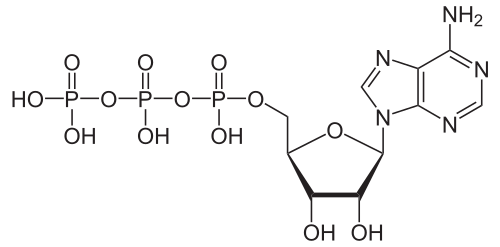 |
| ATP Molecule |
ATP is called the energy currency of cells because all work performed in the cell uses this molecule, which can be saved until needed. Adenosine triphosphate consists of an organic molecule (adenosine) connected to three phosphate groups. In the presence of water ATP will lose one phosphate group, becoming adenosine diphosphate. Not only the prime energy currency of cells, it is also an ingredient in RNA production.
The phosphate groups on the ATP molecule have a bond that is easily broken via hydrolysis, which simply means the introduction of water. The process releases energy used to perform work. The amount of energy produced is relatively large, primarily because the phosphate groups are all negatively charged and bunched together.
The following video gives quite a bit of info on ATP with some cellular respiration thrown in. Enjoy!
No comments:
Post a Comment